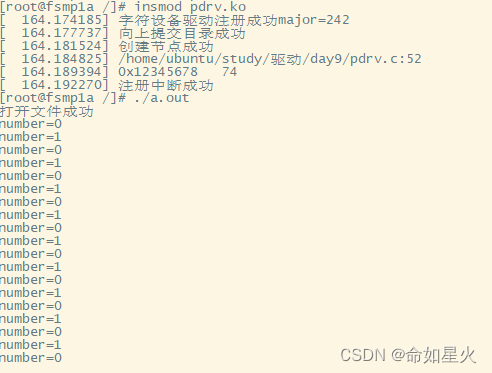通过platform总线驱动实现
-
应用程序通过阻塞的io模型来读取number变量的值
-
number是内核驱动中的一个变量
-
number的值随着按键按下而改变(按键中断) 例如number=0 按下按键number=1 ,再次按下按键number=0
-
在按下按键的时候需要同时将led1的状态取反
-
驱动中需要编写字符设备驱动 f.驱动中需要自动创建设备节点
-
这个驱动需要的所有设备信息放在设备树的同一个节点
驱动文件
#include <linux/of.h>
#include <linux/of_irq.h>
#include <linux/interrupt.h>
#include <linux/fs.h>
#include <linux/io.h>
#include <linux/cdev.h>
#include <linux/ioctl.h>
#include <linux/device.h>
#include <linux/uaccess.h>
#include <linux/slab.h>
#include <linux/gpio.h>
#include <linux/of_gpio.h>
#define CNAME "mycdev"
unsigned int major;
char kbuf[128]={};//定义数组用于存放和用户之间拷贝的数据
int *p=(int*)kbuf;
struct class *cls;//句柄
struct device *dev;
//定义队列头
wait_queue_head_t wq_head;
//判断是否有数据准备好的标识变量
unsigned int condition=0;
int number=0;
struct resource *res;
int irqno;
struct gpio_desc *desc;
//中断处理函数
irqreturn_t irq_handler(int irq,void *dev)
{
//电位反转
number=number%2;
gpiod_set_value(desc,number);
*p=number; //将反转后的电平状态保存
number++;
//唤醒
condition=1;
wake_up_interruptible(&wq_head);
return IRQ_HANDLED;
}
int pdrv_probe(struct platform_device *pdr)
{
int ret;
printk("%s:%dn",__FILE__,__LINE__);
res=platform_get_resource(pdr,IORESOURCE_MEM,0);
if(res==NULL)
{
printk("获取资源失败n");
return -ENODATA;
}
irqno=platform_get_irq(pdr,0);
if(irqno<0)
{
printk("获取资源失败n");
return irqno;
}
printk("%#x %dn",res->start,irqno);
//获取GPIO编号
desc=gpiod_get_from_of_node(pdr->dev.of_node,"led2",0,GPIOD_OUT_HIGH,NULL);
if(IS_ERR(desc))
{
printk("获取GPIO编号失败n");
return PTR_ERR(desc);
}
//注册中断
ret=request_irq(irqno,irq_handler,IRQF_TRIGGER_FALLING,"key2_inte",NULL);
if(ret)
{
printk("注册中断失败n");
return ret;
}
printk("注册中断成功n");
//初始化队列头
condition=0;
init_waitqueue_head(&wq_head);
return 0;
}
int pdrv_remove(struct platform_device *pdr)
{
free_irq(irqno,NULL);
gpiod_set_value(desc,0);
gpiod_put(desc);
printk("%s:%dn",__FILE__,__LINE__);
return 0;
}
//定义名字表
struct of_device_id oftable[]={
{.compatible="hqyj,platform"},
{},
};
MODULE_DEVICE_TABLE(of,oftable);
//定义并初始化对象
struct platform_driver pdrv ={
.probe=pdrv_probe,
.remove=pdrv_remove,
.driver={
.name="test",
.of_match_table=oftable,//设备树匹配
},
};
//read()
ssize_t mycdev_read(struct file *file, char __user *ubuf, size_t size, loff_t *loff)
{
//size参数是用户期待读到的字节长度
int ret;
if(file->f_flags&O_NONBLOCK)
{
//非阻塞,退出
return -EINVAL;
}
else{
//阻塞
ret=wait_event_interruptible(wq_head,condition);
if(ret)
{
printk("接收阻塞休眠n");
return ret;
}
}
if(size>sizeof(kbuf))
size=sizeof(kbuf);
ret=copy_to_user(ubuf,kbuf,size);
if(ret)
{
printk("数据从内核向用户拷贝失败n");
return -EIO;
}
condition=0;
return size;
}
//操作方法结构体的初始化
struct file_operations fops=
{
.read=mycdev_read,
};
static int __init mycdev_init(void)
{
//动态注册字符设备驱动
major=register_chrdev(0,CNAME,&fops);
if(major<0)
{
printk("字符设备驱动注册失败n");
return major;
}
printk("字符设备驱动注册成功major=%dn",major);
//向上提交节点目录
cls=class_create(THIS_MODULE,"LED");
if(IS_ERR(cls))
{
printk("向上提交目录失败n");
return PTR_ERR(cls);
}
printk("向上提交目录成功n");
//创建设备节点文件
dev=device_create(cls,NULL,MKDEV(major,0),NULL,"myled");
if(IS_ERR(dev))
{
printk("创建节点失败n");
return PTR_ERR(dev);
}
printk("创建节点成功n");
platform_driver_register(&pdrv);
return 0;
}
static void __exit mycdev_exit(void)
{
//注销对象
platform_driver_unregister(&pdrv);
//注销中断
free_irq(irqno,NULL);
//释放设备号
gpiod_set_value(desc,0);
gpiod_put(desc);
//销毁节点
device_destroy(cls,MKDEV(major,0));
//销毁目录
class_destroy(cls);
//注销字符设备驱动
unregister_chrdev(major,CNAME);
}
module_init(mycdev_init);
module_exit(mycdev_exit);
MODULE_LICENSE("GPL");
MODULE_AUTHOR("zhangyang_sh@hqyj.com");test.c——测试用的应用程序
#include<stdio.h>
#include<sys/types.h>
#include<sys/stat.h>
#include<fcntl.h>
#include<unistd.h>
#include<stdlib.h>
#include<string.h>
#include<sys/ioctl.h>
#include<sys/wait.h>
int main(int argc,char const *argv[])
{
int fd,number;
fd=open("/dev/myled",O_RDWR);
if(fd<0)
{
printf("打开文件失败n");
exit(-1);
}
printf("打开文件成功n");
while(1)
{
read(fd,&number,sizeof(number));
printf("number=%dn",number);
}
close(fd);
return 0;
}实验现象

最后
以上就是机灵猫咪最近收集整理的关于2022/10/20——platform总线驱动练习的全部内容,更多相关2022/10/20——platform总线驱动练习内容请搜索靠谱客的其他文章。
本图文内容来源于网友提供,作为学习参考使用,或来自网络收集整理,版权属于原作者所有。








发表评论 取消回复